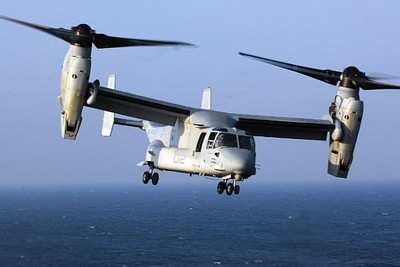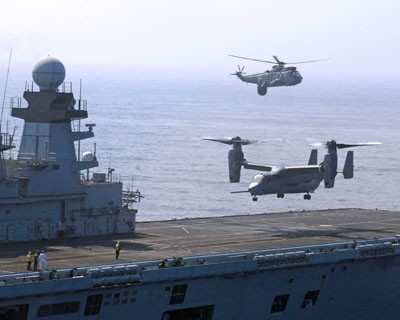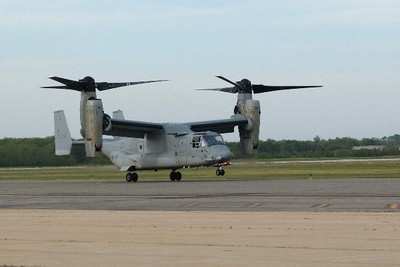Local Governments Pass Ordinances Opposed To The Move
The U.S. military says it will go ahead with the deployment of a dozen MV-22 Osprey aircraft at American bases in Japan despite local protests and ordinances which strongly oppose the move. At a Pentagon news conference Friday, Defense Secretary Leon E. Panetta said U.S. officials have had “very good discussions with our Japanese allies” and have given them assurances regarding concerns about the aircraft’s safety record.

“But the important thing, we felt, was to be able to deploy these planes there, and that we will continue to brief them with regards to the operations of these planes,” the secretary said.
“Actually, we think we've reached a very good compromise here. … I think we've been able to relieve their concerns with what we've presented to them,” Panetta continued. “But we're going to continue to work with them. The good thing is that our ability to deploy these forces will certainly help us with regards to our whole rebalancing to the Asia-Pacific region.”
Recent accidents involving an MV-22 and a CV-22 aircraft raised concerns about the fleet upgrade by the governor of Okinawa, Pentagon Press Secretary George Little said June 20. Senior Defense Department officials briefed a Japanese delegation on the incidents at the Pentagon June 22.
On April 11 in Morocco, an MV-22 crashed while taking part in a bilateral military exercise. Two on board the aircraft were fatally injured, and two others sustained serious injuries. Flight data indicates the aircraft performed as expected. In a statement, DOD officials said the U.S. Marine Corps determined the aircraft did not suffer a mechanical or material failure and there were no problems with the aircraft’s safety.
Earlier this month, a CV-22 crashed during a training mission in Navarre, Fla., leaving five crew members injured. A preliminary review uncovered no information that would preclude the aircraft’s continued operation, Pentagon officials said.

The Defense Department, including senior U.S. Air Force leaders, stands behind the CV-22's reliability and is convinced the aircraft is safe for operation, officials said in a statement.
The MV-22 Osprey operates with the speed and range of a turboprop, the maneuverability of a helicopter and the ability to carry 24 Marine combat troops. It travels twice as fast and five times farther than previous helicopters.
The Air Force CV-22 Osprey is a special operations variant of the aircraft. It can fly like an airplane and land like a helicopter.
The DoD says the MV-22 Osprey has an excellent safety record and has logged more than 115,000 flight hours, the Defense Department statement said. About a third of those flight hours were flown during the last two years, the statement continued, and the Osprey achieved these flight hours performing combat operations, humanitarian assistance, training, and test and evaluation missions.

Basing the Osprey in Okinawa will strengthen the U.S. ability to provide for the defense of Japan, perform humanitarian assistance and disaster relief operations, and fulfill other alliance roles, the Pentagon statement said.
But Bloomberg Business Week reports that the move was the subject of a protest by about 5,000 people on June 17th, and that the local governments in Iwakuni and Ginowan on the island of Okinawa have passed resolutions against the deployment.
In response to remaining safety concerns, officials said, the DoD said in a statement that the MV-22 will not fly in Japan until results of the investigations are presented to the Japanese government in August. During this time, Japan will be the only location worldwide, including the continental United States, where MV-22 flight operations will be suspended, they added.
 ANN's Daily Aero-Linx (06.29.25)
ANN's Daily Aero-Linx (06.29.25) ANN's Daily Aero-Term (06.29.25): Gross Navigation Error (GNE)
ANN's Daily Aero-Term (06.29.25): Gross Navigation Error (GNE) Classic Aero-TV: Anticipating Futurespace - Blue Origin Visits Airventure 2017
Classic Aero-TV: Anticipating Futurespace - Blue Origin Visits Airventure 2017 NTSB Final Report: Cirrus SR22
NTSB Final Report: Cirrus SR22 Airborne Affordable Flyers 06.26.25: PA18 Upgrades, Delta Force, Rhinebeck
Airborne Affordable Flyers 06.26.25: PA18 Upgrades, Delta Force, Rhinebeck





